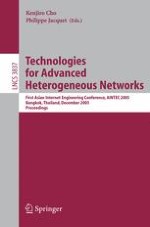The Asian Internet Engineering Conference (AINTEC) brings together researchers and engineers interested in practical and theoretical problems in Internet technologies. The conference aims at addressing issues pertinent to the Asian region with vast diversities of socio-economic and networking conditions while inviting high-quality and recent research results from the global inter- tional research community. The ?rst event was jointly organized by the Internet Education and Research Laboratory of the Asian Institute of Technology (AIT) and the WIDE Project with support from the APAN-TH community. In response to the recent natural disaster in Asia, AINTEC 2005 solicited papers, among other things, on the survival of the Internet in order to provide alternative means of communication in emergency and chaotic situations. The main topics include: Mobile IP Mobile Ad Hoc and Emergency Networks Multimedia or Multi-Services IP-Based Networks Peer-to-Peer Measurement and Performance Analysis Internet over Satellite Communications There were 52 submissions to the Technical Program,and we selected the 18 papers presented in these proceedings. In addition, we have three invited papers and one invited position paper by leading experts in the ?eld. Finally, we would like to acknowledge the conference General Chair, K- chana Kanchanasut of AIT, and the Local Organizers team from AIT, namely, Pensri Arunwatanamongkol, Withmone Tin Latt and Yasuo Tsuchimoto, for organizing and arranging this conference. We are also grateful to the French Ministry of Foreign A?airs through its French Regional Cooperation and the ICT Asia project (STIC-ASIE) for providing travel support.
